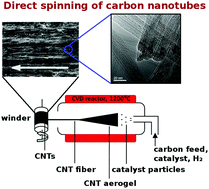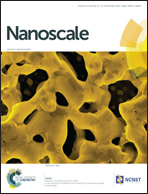Carbon nanotube fibers and films: synthesis, applications and perspectives of the direct-spinning method
Abstract
The direct-spinning method of creation of CNT macroassemblies has received a lot of attention because of its simplicity to produce high-performance material without apparent limits to its size. CNT fibers or films have shown unparalleled properties and opened new areas of research and commercial development. The process designed more than a decade ago has already given interesting information about the basic science of nanomaterials, which in parallel led to the creation of the first prototypes with high potential of implementation in everyday life. Because of this, there has been growing interest in this technique with research articles coming into view from all around the world on a frequent basis. This review aims to summarize all the progress made in the direct-spinning process on a spectrum of fronts ranging from the study of complex synthesis parameters, material properties to its viable applications. The strong and weak points of the “Cambridge process” are carefully evaluated to put forward what challenges are most pressing. The future overlook puts the state of the art into perspective and suggests the prospective research directions.



 Please wait while we load your content...
Please wait while we load your content...